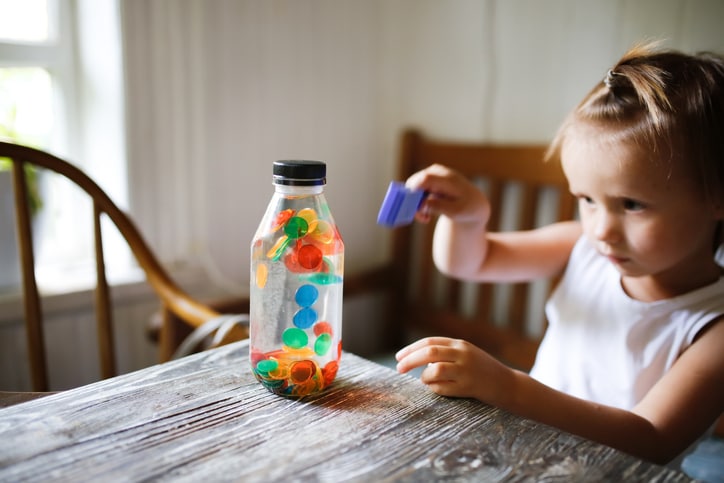Ask any parent, teacher or child — learning to read and write is not always an easy task. “The English language is very complicated,” explains Rodney Everson, creator of the OnTrack Reading phonics program. “Many letters represent several sounds.”. For example, the letter “n” is always pronounced the same, whether it is being read in the words run, runner, gnat or know. However, the letter /a/ can be pronounced /a/ as in apple, /ay/ as in cape, /ah/ as in wash, /uh/ as in was, or sometimes the letter /a/ isn’t heard at all, as in the word beak — or heard.
“It’s a common misconception that reading comes naturally,” explains Everson. “Reading is unnatural, and that’s why teaching phonics at a young age is crucial.”
Whether a child is struggling with reading or this is their first introduction to letter sounds, phonics helps children learn to read and write by correlating sounds with letters or groups of letters to form words. Here’s what you need to know about letter sounds and the best methods to teach phonics to kids, according to the experts.
What is phonics?
“Phonics is matching the sounds of spoken English with individual letters or groups of letters,” explains Judy Araujo, a reading specialist in Boston. “There are 44 sounds — or phonemes — in English, but there are many ways to represent sounds. For example, the /k/ sound can be written as ‘c,’ ‘k,’ ‘ck’ or ‘ch’ as in Christmas and que in bouquet.”
With such a complex concept, it’s best to explain phonics simply to kids, suggests Everson. “I’ll start a phonics lesson by drawing a traffic light — one red circle at the top and one green circle at the bottom of the rectangle,” describes Everson. “I’ll say ‘the red circle is code for stop, and the green circle is code for go.’ If we didn’t understand the codes for those lights, we would have a real mess at an intersection. Phonics is simply the code for how each letter of the alphabet is pronounced.”
Sight words — meaning words that can only be recognized through memorization versus sounding out — are especially tricky — such as “the,” “where” or “do.” “Nonetheless, encourage your child to use phonics to decode the word parts that are decodable,” says Araujo. “For example, for “said,” /s/ and /d/ can be decoded. The child must remember /ai/ as having the short /e/ sound in this case.”
Teaching phonics to kids comes with its challenges. “Just be patient,” advises Arajuo. “Repetition is key.”
Teaching phonics to kids sets the stage for a lifelong benefit. “As we connect the pronunciation and meaning of words with their spelling, we create neural pathways that allow us to remember written words,” says Arajuo. “Once a developing reader has looked carefully at a word a few times, sounded it out and figured out what the word means, the written form gets mapped into memory.”
How to teach phonics
“Keep the lessons simple and fun,” suggests Cynthia Seeley, a reading tutor and mom of two in Lake Wylie, South Carolina. “Don’t try to cover too many letter sounds in one sitting — one is enough. But, do introduce high frequency words that your child sees daily — like “mom,” “dad,” “cat,” or “dog.’”
Keep the following steps in mind when introducing phonics to your child, recommends Seeley.
5 steps for teaching phonics
1. Introduce the sounds of each consonant of the alphabet.
Omit the vowels at first, since they are more complex than consonants.
2. Teach short vowel sounds.
Once the child masters the sound of each consonant, you can teach them the short vowel sound of /a/, /e/, /i/ and /o/. Keep /y/ as a consonant sound only for now.
3. Practice three-letter “CVC” words.
Next, practice three-letter consonant/vowel/consonant (CVC) words, such as “cat,” “bed,” “pin” and “log.”
4. Teach letter digraphs.
Once the CVC words are mastered, you can move on to teaching letter digraphs, which are two-consonant blends at the beginning or end of a word. The list of digraphs are as follows: bl, br, ch, ck, cl, cr, dr, fl, fr, gh, gl, gr, ng, ph, pl, pr, qu, sc, sh, sk, sl, sm, sn, sp, st, sw, th, tr, tw, wh, and wr. For example, “shut,” “mash,” “snip” and “with.”
5. Add in long vowels.
Finally, add in the long vowel sounds, plus /y/. Such as, “cake,” “bead,” “hive,” “joke,” “tube” and “baby.”
Fun ways to practice phonics with kids
Now that you know the order in which to teach letter sounds, here are some exciting tips and tricks for keeping your child engaged during a reading lesson.
Try flash cards
When introducing the letter sounds, Seeley loves using flash cards. “Sometimes we will make an alphabet train with the cards,” she notes, explaining that each card has a letter of the alphabet on it and is placed in a long line on the floor. If the child knows the letter sound, they get to flip the card over, if not, the letter stays facing upward. Continue playing until the child correctly identifies all 26 letters of the alphabet and their phonetic sound.
Use sticky notes
Seeley suggests labeling common items around the house or in the car with a sticky note to encourage reading throughout the day. “Label everything — from easier words such as sink and cup to the more challenging words such as chair and light — seeing these words everyday will make a huge difference in their ability to read and decode words,” she points out.
Play hide-and-seek
“Incorporating familiar games that your child already loves is a great way to practice letter sounds,” notes Seeley. “Take the flash cards and hide them around the house. Have your child play hide-and-seek for the flash card that matches the letter sound you say,” Seeley recommends.
Try sight word bingo
For trickier reading concepts, like sight words, you can make a sight word bingo game to practice identifying these challenging words. “Fill out a blank bingo card with common sight words, and say the word aloud as the child searches for the correct one until they fill up their board,” advises Seeley.
Read rhyming books together
Rhyming books with simple CVC words — think “Hop on Pop” by Dr. Seuss — are perfect for reinforcing letter sounds. “And when the book is done, you can go back and forth with the child to come up with more rhyming words to practice the letter sounds,” says Seeley.
Additional resources for teaching phonics to kids
“Reading fluency comes with a lot of practice,” says Everson. “Aim to work on phonics with your child daily.” Here, some engaging ways to keep your child excited about learning to read.
Electronics
There are countless online games that are helpful in teaching letter sounds, phonetic awareness and sight words. “Some of the popular electronic games are Leap Frog, Star Fall and ABCmouse.com,” Seeley says.
Games
In addition to flash cards, there are spin-and-read letter blocks, the movable alphabet and a timeless classic — Scrabble. These games will keep your child engaged and excited to read.
Books
Grab a library card, and check out simple CVC or rhyming books. Dr. Seuss, BOB Books and the “I Can Read” series are some of the popular picks among emerging readers.
Professional help
A professional will be able to discern if your child has a reading disability, such as dyslexia, or not. At the first sign of reading struggles, make sure to get on the same page as your child’s teacher,” suggests Seeley. “There are reading specialists, tutors and extra help offered by your child’s teacher available to them.”
Everson also advises looking into an appointment with the optometrist. According to the American Optometric Association, 25% of all children have a vision problem significant enough to impact their learning.
The bottom line on phonics for kids
As you begin to teach your child phonics, there are endless opportunities to practice reading and sounding out words just about everywhere. In addition to reading labels at the grocery store and putting the closed captioning on while your child watches their favorite television show, you can make recognizing letters and words a regular practice. “Read aloud to your child daily,” suggests Araujo. “Point out signs in the community and on cereal boxes — words your child may know — and discuss the letters and their sounds.”
As Seeley notes, repetition can make all the difference, noting, “Like anything else that a child wants to be better at — practice, practice, practice.”




